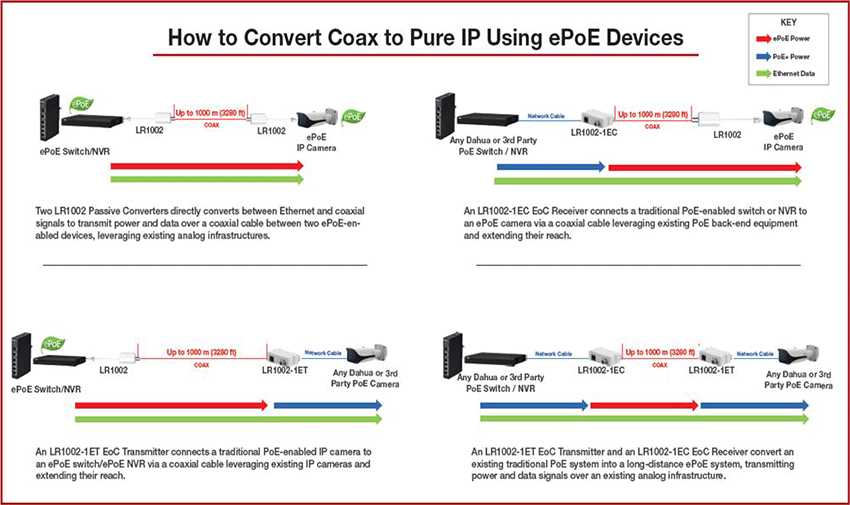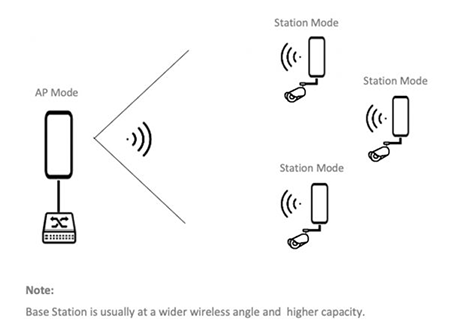Blog
How to Choose the Right Transmission Device
SHARE
19
May 13, 2021

Dahua’s transmission products are a key part of comprehensive security solutions, connecting devices while providing efficient data and power transmission. Our network switches help future-proof video surveillance systems by allowing for long-distance signaling without having to replace cable or switch infrastructure. Our ePoE devices are 100% backward compatible with PoE* and eliminate the need for multiple switches because they connect IP cameras via twisted pair or coaxial cable. Whether you need wired or wireless, PoE or ePoE, there’s a switch or accessory in our broad product line that offers long-distance cabling options and saves you time and money.
Know Your Specs
For
wired transmission, choosing the right switch for your application will depend
on the distance you need to cover, the number of devices you need to connect
(which will affect the amount of power you need), and the speed of the network.
You don’t need a gigabit connection on all PoE ports: most IP cameras will require only 4-12 Mbps bandwidth, so a 10/100 Mbps connection is fine. However, you should choose a switch with Gigabit uplink ports (e.g., PoE switches). This will provide enough aggregate bandwidth for all connected IP cameras on the main network.
Remember that high-to-average IP camera PoE power consumption is around 8W, but the camera will consume more during the power-on surge. For this reason, it’s safer to spec 25% higher: 10-12.5 W. When you review your power budget, carefully make sure your PoE switch has enough system capacity to power all PoE ports. For example, some 24-port PoE switches have only 180W. Assuming that each IPC occupies 10W, then only 18 ports can work simultaneously.
Consider Which Features You Truly Need
You
don’t necessarily need the most advanced network features, such as Link
Aggregation, when choosing a PoE switch for an IP camera system. A PoE switch
is normally used at the edge of the network, which in most cases won’t require
the most complex or costliest features.
One of the more desirable options is to use a managed switch. Dahua does offer a full range of switches from Core Switch to L2+ Managed Switch, which gives you the ability to remotely configure, manage and monitor your LAN and switch options. Managed switches also let an admin remotely cycle power to an IP camera to easily reboot it without deploying a technician.
Leverage ePoE for Cost Efficiency
Our
patented Enhanced Power Over Ethernet
(ePoE) technology represents one of the industry’s most
flexible line of transmission devices. It’s compatible with our ePoE cameras for
extended distances, and with third-party devices, ONVIF, PoE and IP cameras at
regular distances. The ePoE technology transmits video, data, and power up to
800 m (2624 ft) at 10 Mbps via a single CAT5E cable between an IP camera and a
switch, or an IP camera and NVR. This distance –without repeaters –is
three to eight times longer than standard IP devices!
For
further information about Dahua ePOE, you can watch this demo video.
ePoE saves money for several reasons. First, it requires fewer midspan devices to connect each front-end device to the back end over 100 meters. In addition, ePoE systems avoid expensive fiber solutions at distances up to 800 meters. Finally, ePoE provides extended distances over coaxial cable with adapters. Using existing infrastructure significantly reduces installation cost and time. The infographic below explains how you can use ePoE devices to convert coax to pure IP.

Use Wireless for Challenging Environments
There
are many applications that are not conducive to laying cable, such as mining
operations, rural areas and construction sites. In those situations, wireless
transmission points create bridges to transmit data without cabling. Our
wireless base station and wireless CPE have advanced radio cores containing
5Ghz MIMO 2 x 2 technology with directional antennas providing reliable
connectivity. The base station and CPE can be configured as point-to-point,
point-to-multi-point, or back-to-back.

For a point-to-multi-point connection, we recommend one base station, which has a wider wireless angle and higher capacity, working in Access Point (AP) mode. This is paired with several CPEs working in station mode.

A back-to-back configuration is suitable for
areas where there is an obstacle such as building between the client and AP.
When a client device can’t otherwise transmit data to the center AP directly,
back-to-back deployment provides a method to adjust the angle of transmission.
To learn more about Dahua
transmission devices, click here.
TOPIC:













